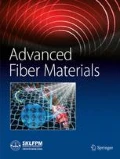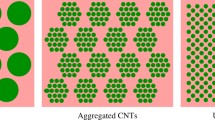Abstract
Carbon nanotubes (CNTs) have generated remarkable interests in a wide range of research fields due to their excellent electrical properties. However, achieving the CNTs arrangement with high quality in a short time remains a challenge. Herein we studied the in-situ assembly of CNTs based on macroscopic dielectrophoresis by using a centimeter scale electrode, which overcome the limitation of small size in traditional method for manipulating nanoparticles. Ordered CNTs chains could be obtained under the action of alternating current dielectrophoresis by optimizing the voltage and frequency. Besides, the ordered chains were able to restore immediately upon powering up after being damaged. Furthermore, a CNTs chain was prepared for conducting the wet circuit and powering a LED, and different conductive patterns on the non-woven fabric were achieved by controlling the position of the electrodes in wet environment.




Similar content being viewed by others
References
Huang Y, Duan XF, Wei QQ, Lieber CM. Directed assembly of one-dimensional nanostructures into functional networks. Science. 2001;291:630–3.
Lipomi DJ, Vosgueritchian M, Tee BCK, Hellstrom SL, Lee JA, Fox CH, Bao ZN. Skin-like pressure and strain sensors based on transparent elastic films of carbon nanotubes. Nat Nanotechnol. 2011;6:788–92.
Yamada T, Hayamizu Y, Yamamoto Y, Yomogida Y, Izadi-Najafabadi A, Futaba DN, Hata K. A stretchable carbon nanotube strain sensor for human-motion detection. Nat Nanotechnol. 2011;6:296–301.
Ryoo SR, Kim YK, Kim MH, Min DH. Behaviors of NIH-3T3 fibroblasts on graphene/carbon nanotubes: proliferation, focal adhesion, and gene transfection studies. ACS Nano. 2010;4:6587–98.
Pinto AM, Moreira S, Goncalves IC, Gama FM, Mendes AM, Magalhaes FD. Biocompatibility of poly (lactic acid) with incorporated graphene-based materials. Colloids Surf B Biointerfaces. 2013;104:229–38.
Hou HL, Shao G, Yang WY, Wong WY. One-dimensional mesoporous inorganic nanostructures and their applications in energy, sensor, catalysis and adsorption. Prog Mater Sci. 2020;113:100671.
Franklin AD, Luisier M, Han SJ, Tulevski G, Breslin CM, Gignac L, Lundstrom MS, Haensch W. Sub-10 nm carbon nanotube transistor. Nano Lett. 2012;12:758–62.
Lee CS, Pop E, Franklin AD, Haensch W, Wong HSP. A compact virtual-source model for carbon nanotube field-effect transistors in the sub-10-nm regime-part I intrinsic elements. IEEE Trans Electron Devices. 2015;62:3061–9.
Lundstrom MS, Antoniadis DA. Compact models and the physics of nanoscale FETs. IEEE Trans Electron Devices. 2014;61:225–33.
Avouris P, Chen ZH, Perebeinos V. Carbon-based electronics. Nat Nanotechnol. 2007;2:605–15.
Bai YX, Zhang RF, Ye X, Zhu ZX, Xie HH, Shen BY, Cai DL, Liu BF, Zhang CX, Jia Z, Zhang SL, Li XD, Wei F. Carbon nanotube bundles with tensile strength over 80 GPa. Nat Nanotechnol. 2018;13:589–97.
Li LP, Fan HW, Hou CY, Zhang QH, Li YG, Yu H, Wang HZ. Highly aligned molybdenum trioxide nanobelts for flexible thin-film transistors and supercapacitors: macroscopic assembly and anisotropic electrical properties. ACS Appl Nano Mater. 2019;2:1466–71.
Xiong L, Dai JH, Song Y, Wen GW, Xia L, Wu X. Effects of doping on photoelectrical properties of one-dimensional α-Si3N4 nanomaterials: a first-principles stud. Phys B. 2018;550:32–8.
Zhang RF, Zhang YY, Wei F. Controlled synthesis of ultralong carbon nanotubes with perfect structures and extraordinary properties. Acc Chem Res. 2017;50:179–89.
Peng B, Locascio M, Zapol P, Li SY, Mielke SL, Schatz GC, Espinosa HD. Measurements of near-ultimate strength for multiwalled carbon nanotubes and irradiation-induced crosslinking improvements. Nat Nanotechnol. 2008;3:626–31.
Zhao QZ, Nardelli MB, Bernholc J. Ultimate strength of carbon nanotubes: a theoretical study. Phys Rev B. 2002;65:144105.
Zhang R, Wen Q, Qian W, Su DS, Zhang Q, Wei F. Superstrong ultralong carbon nanotubes for mechanical energy storage. Adv Mater. 2011;23:3387–91.
He XW, Gao WL, Xie LJ, Li B, Zhang Q, Lei SD, Robinson JM, Haroz EH, Doorn SK, Wang WP, Vajtai R, Ajayan PM, Adams WW, Hauge RH, Kono J. Wafer-scale monodomain films of spontaneously aligned single-walled carbon nanotubes. Nat Nanotechnol. 2016;11:633–39.
Headrick RJ, Tsentalovich DE, Berdegue J, Bengio EA, Liberman L, Kleinerman O, Lucas MS, Talmon Y, Pasquali M. Structure-Property relations in carbon nanotube fibers by downscaling solution processing. Adv Mater. 2018;30:1704482.
Liu LJ, Han J, Xu L, Zhou JS, Zhao CY, Ding SJ, Shi HW, Xiao MM, Ding L, Ma Z, Jin CH, Zhang ZY, Peng LM. Aligned, high-density semiconducting carbon nanotube arrays for high-performance electronics. Science. 2020;368:850–6.
Kang SJ, Kocabas C, Ozel T, Shim M, Pimparkar N, Alam MA, Rotkin SV, Rogers JA. High-performance electronics using dense, perfectly aligned arrays of single-walled carbon nanotubes. Nat Nanotechnol. 2007;2:230–6.
Mcnicholas TP, Ding L, Yuan D, Liu J. Density enhancement of aligned single-walled carbon nanotube thin films on quartz substrates by sulfur-assisted synthesis. Nano Lett. 2009;9:3646–50.
Hong SW, Banks T, Rogers JA. Improved density in aligned arrays of single-walled carbon nanotubes by sequential chemical vapor deposition on quartz. Adv Mater. 2010;22:1826–30.
Kocabas C, Hur SH, Gaur A, Meitl MA, Shim M, Rogers JA. Guided growth of large-scale, horizontally aligned arrays of single-walled carbon nanotubes and their use in thin-film transistors. Small. 2005;1:1110–6.
Zhou WW, Rutherglen C, Burke PJ. Wafer scale synthesis of dense aligned arrays of single-walled carbon nanotubes. Nano Res. 2008;1:158–65.
Fischer JE, Zhou W, Vavro J, Llaguno MC, Guthy C, Haggenmueller R, Casavant MJ, Walters DE, Smalley RE. Magnetically aligned single wall carbon nanotube films: preferred orientation and anisotropic transport properties. J Appl Phys. 2003;93:2157–63.
Smith BW, Benes Z, Luzzi DE, Fischer JE, Walters DA, Casavant MJ, Schmidt J, Smalley RE. Structural anisotropy of magnetically aligned single wall carbon nanotube films. Appl Phys Lett. 2000;77:663–5.
Bubke K, Gnewuch H, Hempstead M, Hammer J, Green MLH. Optical anisotropy of dispersed carbon nanotubes induced by an electric field. Appl Phys Lett. 1997;71:1906–8.
Chen XQ, Saito T, Yamada H, Matsushige K. Aligning single-wall carbon nanotubes with an alternating-current electric field. Appl Phys Lett. 2001;78:3714–6.
Kiani K. Application of nonlocal higher-order beam theory to transverse wave analysis of magnetically affected forests of single-walled carbon nanotubes. Int J Mech Sci. 2018;138:1–16.
Hobbie EK, Wang H, Kim H, Han CC, Grulke EA, Obrzut J. Optical measurements of structure and orientation in sheared carbon-nanotube suspensions. Rev Sci Instrum. 2003;74:1244–50.
Yu GH, Cao AY, Lieber CM. Large-area blown bubble films of aligned nanowires and carbon nanotubes. Nat Nanotechnol. 2007;2:372–7.
Yu GH, Li XL, Lieber CM, Cao AY. Nanomaterial-incorporated blown bubble films for large-area, aligned nanostructures. J Mater Chem. 2008;18:728–34.
Azoz S, Exarhos AL, Marquez A, Gilbertson LM, Nejati S, Cha JJ, Zimmerman JB, Kikkawa JM, Pfefferle LD. Highly conductive single-walled carbon nanotube thin film preparation by direct alignment on substrates from water dispersions. Langmuir. 2015;31:1155–63.
Mclean RS, Huang XY, Khripin C, Jagota A, Zheng M. Controlled two-dimensional pattern of spontaneously aligned carbon nanotubes. Nano Lett. 2006;6:55–60.
Vijayaraghavan D. Self-assembled ordering of single-walled carbon nanotubes in a lyotropic liquid crystal system. J Mol Liq. 2014;199:128–32.
Joo Y, Brady GJ, Arnold MS, Gopalan P. Dose-controlled, floating evaporative self-assembly and alignment of semiconducting carbon nanotubes from organic solvents. Langmuir. 2014;30:3460–6.
Bornhoeft LR, Castillo AC, Smalley PR, Kittrell C, James DK, Brinson BE, Rybolt TR, Johnson BR, Cherukuri TK, Cherukuri P. Teslaphoresis of carbon nanotubes. ACS Nano. 2016;10:4873–81.
House DL, Luo HX, Chang SY. Numerical study on dielectrophoretic chaining of two ellipsoidal particles. J Colloid Interface Sci. 2012;374:141–9.
Pethig R. Review article-dielectrophoresis: status of the theory, technology, and applications. Biomicrofluidics. 2010;4:022811.
Shekhar S, Stokes P, Khondaker SI. Ultrahigh density alignment of carbon nanotube arrays by dielectrophoresis. ACS Nano. 2011;5:1739–46.
Freer EM, Grachev O, Duan XF, Martin S, Stumbo DP. High-yield self-limiting single-nanowire assembly with dielectrophoresis. Nat Nanotechnol. 2010;5:525–30.
Velev OD, Bhatt KH. On-chip micromanipulation and assembly of colloidal particles by electric fields. Soft Matter. 2006;2:738–50.
Rouhi N, Jain D, Burke PJ. High-performance semiconducting nanotube inks: progress and prospects. ACS Nano. 2011;5:8471–8.
Velev OD, Gupta S. Materials fabricated by micro- and nanoparticle assembly- the challenging path from science to engineering. Adv Mater. 2009;21:1897–905.
Kim B, Norman TJ, Jones RS, Moon DI, Han JW, Meyyappan M. Carboxylated single-walled carbon nanotube sensors with varying pH for the detection of ammonia and carbon dioxide using an artificial neural network. ACS Appl Nano Mater. 2019;2:6445–51.
Shannahan JH, Brown JM, Chen R, Ke PC, Lai X, Mitra S, Witzmann FA. Comparison of nanotube–protein corona composition in cell culture media. Small. 2013;9:2171–81.
Khodadadian A, Hosseini K, Manzour-Ol-Ajdad A, Hedayati M, Kalantarinejad R, Heitzinger C. Optimal design of nanowire field-effect troponin sensors. Comput Biol Med. 2017;87:46–56.
Khodadadian A, Parvizi M, Heitzinger C. An adaptive multilevel Monte Carlo algorithm for the stochastic drift-diffusion-Poisson system. Comput Method Appl M. 2020;368:113163.
Khodadadian A, Stadlbauer B, Heitzinger C. Bayesian inversion for nanowire field-effect sensors. J Comput Electron. 2020;19:147–59.
Khodadadian A, Taghizadeh L, Heitzinger C. Three-dimensional optimal multi-level Monte-Carlo approximation of the stochastic drift-diffusion-Poisson system in nanoscale devices. J Comput Electron. 2018;17:76–89.
Mirsian S, Khodadadian A, Hedayati M, Manzour-ol-Ajdad A, Kalantarinejad R, Heitzinger C. A new method for selective functionalization of silicon nanowire sensors and Bayesian inversion for its parameters. Biosens Bioelectron. 2019;142:11527.
Acknowledgements
The authors gratefully acknowledge the financial support by the Fundamental Research Funds for the Central Universities (2232019A3-02), DHU Distinguished Young Professor Program (LZB2019002), Innovation Program of Shanghai Municipal Education Commission (2017-01-07-00-03-E00055), China Postdoctoral Science Foundation Grant (2019M651324), State Key Laboratory for Space Power Sources Technology (No. YF07050117F0768), and Shanghai Industrial Technology Center of Graphene.
Author information
Authors and Affiliations
Corresponding authors
Ethics declarations
Conflict of interest
There are no conflicts to declare.
Supplementary Information
Below is the link to the electronic supplementary material.
Supplementary file2 (MP4 3795 KB)
Supplementary file3 (MP4 14437 KB)
Rights and permissions
About this article
Cite this article
Zhao, D., Liu, R., Luo, C. et al. Dielectrophoretic Assembly of Carbon Nanotube Chains in Aqueous Solution. Adv. Fiber Mater. 3, 312–320 (2021). https://doi.org/10.1007/s42765-021-00084-w
Received:
Accepted:
Published:
Issue Date:
DOI: https://doi.org/10.1007/s42765-021-00084-w




